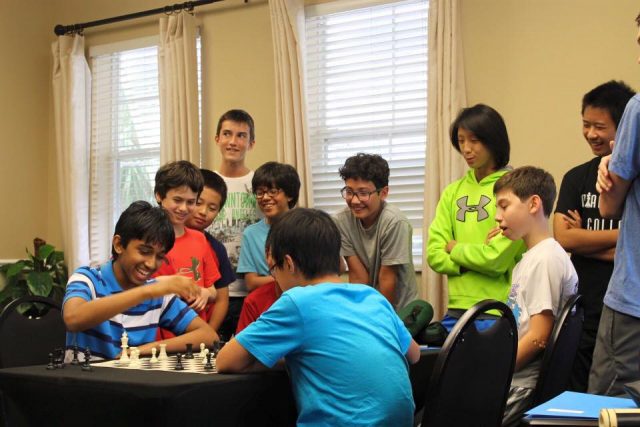
A lot of kids attend camp in the summer. They swim and hike, play sports, make S'Mores and tell ghost stories around a bonfire. So, when I told my friends and family that I am heading off to summer camp, that is exactly what they had in mind. Little did they know that I was off to one of the most intense chess training camps in the country! Having attended one of IM Greg Shahade’s camps in St. Louis the previous summer, I knew what was in store for me, and I was extremely excited to get started. The thirty-sixth US Chess School camp gathered sixteen kids, ages nine-to-nineteen, in a beautiful resort in Orlando, Florida. We all share a love of chess and a commitment to improving our game. Some of us knew each other from many years of playing on the scholastic chess circuit. We were all excited about this great opportunity to learn and play together, away from the pressures of tournaments. Our coach was GM Lars Bo Hansen, an expert on strategic and defensive play. He spent a lot of time talking to us about Stenintz’s theory of balance, attack and defense, calculation, as well as how a player should only plan to attack when he has an advantage. In order to be able to determine whether you have an advantage, you must learn how to correctly evaluate positions! Many players, especially kids, often get nervous when their opponent launches an attack. I should know, I’ve been there many times. If the position is equal, an attack does not necessarily guarantee a win. In an equal position, the attacked does not automatically have an advantage. The defensive player must be careful in evaluating the position, and must continue to play precise and correct defensive moves. Here is an example of a game where white launches an attack in an equal position.
[pgn] [Event "Amsterdam"] [Site "Amsterdam"] [Date "1950.11.16"] [Round "5"] [White "Reshevsky, Samuel Herman"] [Black "Euwe, Max"] [Result "1/2-1/2"] [ECO "E39"] [PlyCount "77"] [EventDate "1950.11.11"] [EventType "tourn"] [EventRounds "19"] [EventCountry "NED"] [Source "ChessBase"] [SourceDate "1999.07.01"] 1. d4 Nf6 2. c4 e6 3. Nc3 Bb4 4. Qc2 c5 5. dxc5 O-O 6. Nf3 Na6 7. Bd2 Nxc5 8. a3 Bxc3 9. Bxc3 b6 {The standard opening line is 9… Nce4, but b6 is a slight inaccuracy. White is about to begin his attack with 10. Ng5, but just because he is attacking doesn’t change the evaluation of the position. It is still equal. If black plays good defense, white will not get a big advantage.} 10. Ng5 {This is the position that Lars presented to the class, tasking us with finding the best moves for white and black. White needs to keep up the attacking initiative, and black has to find the best defensive moves. Many players in the class decided that the best move for black would be to play 10… g6, however that turned out to be a suboptimal move because it weakens the black long diagonal, giving white long-term positional advantages.} Re8 ( 10... g6 11. b4 Na6 12. h4 h6 13. h5 hxg5 14. hxg6 Bb7 15. g7 $18 {The correct move played by Euwe is … Re8, which is based on the defensive “run from the bully” concept that Lars taught us. If you are under attack, escape to a safer place! In this position, the king is going to “run away” to the safety of e7.}) 11. b4 h6 12. h4 hxg5 13. bxc5 gxh4 14. Rxh4 bxc5 15. Qd3 d6 16. g4 Bb7 17. g5 Ne4 18. Rxe4 Bxe4 19. Qxe4 Qxg5 20. Qg2 Qh6 21. Qh3 Qxh3 22. Bxh3 Rab8 23. Bg2 Kf8 24. Kd2 Ke7 25. f4 f6 26. Kc2 Rh8 27. Bf3 Rh4 28. Rg1 Kf7 29. f5 Rxc4 30. fxe6+ Kxe6 31. e4 g5 32. Rh1 Rxc3+ 33. Kxc3 Ke5 34. Rf1 Rf8 35. Bg2 f5 36. exf5 Rxf5 37. Re1+ Kf6 38. Kc4 Rf4+ 39. Kc3 1/2-1/2[/pgn]
As you can see, even though white was attacking, the position was equal. However, since black played good defensive moves, the game ended in a draw. This illustrates one of the most important concepts that we learned in camp -- even if you are under attack, don’t panic, evaluate, and trust the balance of the position.

Lars taught us about three types of advantages: material, dynamic and positional. You must have one or more of these advantages before you begin an attack. For example, look at this recent game between Boris Gelfand and Wang Yue.
[pgn] [Event "Bazna Kings 4th"] [Site "Medias"] [Date "2010.06.14"] [Round "1"] [White "Gelfand, Boris"] [Black "Wang, Yue"] [Result "1-0"] [ECO "D15"] [WhiteElo "2741"] [BlackElo "2752"] [PlyCount "163"] [EventDate "2010.06.14"] [EventType "tourn"] [EventRounds "10"] [EventCountry "ROU"] [EventCategory "20"] [Source "ChessBase"] [SourceDate "2010.07.15"] 1. d4 d5 2. c4 c6 3. Nc3 Nf6 4. e3 a6 5. Nf3 b5 6. c5 g6 7. Ne5 Bg7 8. f4 a5 9. Be2 Qc7 10. O-O O-O 11. a3 Be6 12. Bf3 Nbd7 13. Nd3 {Already, black’s position is extremely cramped, and white wants to avoid exchanges.} h6 14. g4 Nh7 15. h4 f5 16. g5 hxg5 17. hxg5 Kf7 18. Kg2 Rfb8 19. Bd2 Nhf8 20. Be2 Ke8 21. Ne1 Bg8 22. Nf3 Rb7 23. Bd3 Nb8 24. Ne2 Qd8 25. Ng3 e6 26. Rh1 Bh7 { Now black’s plan is to hide his king on g8, but white has so much more space and can start regrouping. Black’s position is much more passive and cramped} 27. Qc2 Kf7 28. Rh3 Kg8 29. Rah1 Raa7 30. Kf1 Qe8 31. Be1 Bh8 32. Rh6 Bg7 33. R6h4 Bh8 34. R1h3 Re7 35. Qh2 Reb7 36. Rh6 Re7 37. Ne2 $1 {Even though white’s position is so much better, he won’t be able to make progress without a pawn break or an opening in the position. By playing Ne2, white is going to be able to bring his knight to b3 via Nc1. Black is then going to be forced to play a4, which will allow white an eventual pawn break with the b-pawn.} Reb7 38. Nc1 Re7 39. Nb3 a4 40. Nc1 Reb7 41. Be2 Re7 42. Nd3 Reb7 43. Nh4 $1 {Now white has the positional advantage -- his pieces are ideally placed! At this point, white has the right to attack, which is exactly what he does.} Bg7 44. Rxh7 $1 Nxh7 {If black plays 44… Kxh7 45. Nxg6 Kg8 46. Rh8 Kf7 47. Nde5 Be5 48. Ne5 +- white wins.} 45. Nxg6 Nd7 46. Bh5 Qd8 47. Nb4 Rc7 48. Nh8 $3 {According to Gelfand, even his analysis engine set to a depth of 20 ply could not find this move. What a brilliant discovery by GM Gelfand! Black cannot take the knight with the king or the bishop because white will play Bf7+-.} Ndf8 49. Nf7 Rxf7 50. Bxf7+ Rxf7 51. Rxh7 Qe8 52. Rh3 Ng6 53. Qe2 Rc7 54. Qh5 Kf7 55. Qh7 Qg8 56. Qxg8+ Kxg8 57. Nd3 Ra7 58. Ke2 Kf7 59. Nb4 Ne7 60. Kd1 Ra8 61. Kc2 Rg8 62. Nd3 Ra8 63. Rh7 Ng6 64. b3 Nf8 65. Rh2 axb3+ 66. Kxb3 Ke8 67. Ra2 Kd7 68. a4 bxa4+ 69. Rxa4 Rxa4 70. Kxa4 Kc8 71. Ba5 Ng6 72. Nb4 Kd7 73. Na6 Kc8 74. Bc7 Bf8 75. Ka5 Kb7 76. Bd6 Be7 77. Bxe7 Nxe7 78. Nb4 Ng8 79. Nd3 Ne7 80. Ne5 Ng8 81. g6 Nf6 82. g7 {White clearly followed the lessons that Lars taught us. He created a positional advantage and then launched his attack, leading to an eventual victory.} 1-0[/pgn]
In addition to evaluation, calculation is another very important aspect of preparation that we discussed extensively in camp. You have to be able to calculate thoroughly and precisely in order to execute advanced combinations. Take a look at this classic game. Many players are familiar with this combination, but do you think you’d be able to calculate the line during a tournament without having seen it before? [pgn] [Event "Amsterdam"] [Site "Amsterdam"] [Date "1889.08.26"] [Round "1"] [White "Lasker, Emanuel"] [Black "Bauer, Johann Hermann"] [Result "1-0"] [ECO "A03"] [PlyCount "75"] [EventDate "1889.08.??"] [EventType "tourn"] [EventRounds "9"] [EventCountry "NED"] [Source "ChessBase"] [SourceDate "1999.07.01"] 1. f4 d5 2. e3 Nf6 3. b3 e6 4. Bb2 Be7 5. Bd3 b6 6. Nf3 Bb7 7. Nc3 Nbd7 8. O-O O-O 9. Ne2 c5 10. Ng3 Qc7 11. Ne5 Nxe5 12. Bxe5 Qc6 13. Qe2 a6 14. Nh5 Nxh5 { At this point, the material is even, but white is in a much better position. He has all his pieces pointed at black’s king side, and black does not have enough pieces defending his king. White has to find the winning combination. Almost all the chess players in class knew what came next!} 15. Bxh7+ {White uses tempo to grab the initiative.} Kxh7 16. Qxh5+ Kg8 17. Bxg7 Kxg7 18. Qg4+ $1 {This is a crucial move that you should never miss in your calculation. If white just plays 18. Rf3, black can save the game by playing 18…. Rg8 followed by Kf8. In this, black is following the correct defensive strategy by “running from the bully,” and giving back material at the right time. In the endgame, black will have two bishops for a rook, allowing for an equal position. However, by playing 18. Qg4, white traps black’s king on the rim and prevents black from being able to escape.} Kh7 19. Rf3 e5 20. Rh3+ Qh6 21. Rxh6+ Kxh6 {White has executed the combination, but because he sacrificed so much, black is up in material. White had to have calculated this from the position after move 14, and seen} 22. Qd7 {which forks both of black’s bishops, allowing white to go up in material and win.} Bf6 23. Qxb7 Kg7 24. Rf1 Rab8 25. Qd7 Rfd8 26. Qg4+ Kf8 27. fxe5 Bg7 28. e6 Rb7 29. Qg6 f6 30. Rxf6+ Bxf6 31. Qxf6+ Ke8 32. Qh8+ Ke7 33. Qg7+ Kxe6 34. Qxb7 Rd6 35. Qxa6 d4 36. exd4 cxd4 37. h4 d3 38. Qxd3 1-0[/pgn]
Many of the chess players in the class had seen this game before, but Lars emphasized how important it is to study the classics, and to review those familiar positions over and over again. After all, they come up quite often! Here is a very recent game we looked at from the 44th World Open, played just this year. See if you can spot some familiar themes. [pgn] [Event "World op 44th"] [Site "Philadelphia"] [Date "2016.07.02"] [Round "4"] [White "Gelashvili, Tamaz"] [Black "Akobian, Varuzhan"] [Result "1-0"] [ECO "D05"] [WhiteElo "2557"] [BlackElo "2612"] [PlyCount "79"] [EventDate "2016.06.30"] [EventType "swiss"] [EventRounds "9"] [EventCountry "USA"] [SourceDate "2016.07.13"] 1. d4 e6 2. Nf3 Nf6 3. e3 c5 4. Bd3 d5 5. b3 Nbd7 6. O-O b6 7. Bb2 Bb7 8. Nbd2 Bd6 9. Ne5 O-O 10. f4 Rc8 11. Nxd7 Nxd7 12. dxc5 {The position is unclear, but white is surely considering the double-bishop sacrifice, because at the very least, white can make perpetual with Qg4 and Qh5. You must have noticed that this position is very similar to the one that we saw in the Lasker-Bauer 1889 game. However, the position in this game is still equal, because black can manipulate his pieces to assist on the king’s side, since his queen is not on c6. More importantly, black’s bishop is on d6 and there is no white pawn protecting e3. In this position black played} Rxc5 $2 {which allows white to execute the double-bishop sacrifice and win a queen. The correct move to equalize the position is 12… Bxc5 followed by 13. Bxh7 Kh7 14. Qh5 Kg8 15. Bxg7 Bxe3, which was not an option in the Lasker-Bauer game because of the pawn defending e3. 16. Kh1 Kg7 17. Qg4 Kh7 18. Rf3 Bxf4!= Black gave the material and the position is now equal. 12… Nxc5 was also an option for black. 13. Bxh7 Kxh7 14. Qh5 Kg8 15. Bg7 f6, again, giving back the material at the right time. After 16. Kxf8 white is going to be slightly better in the endgame because of the week f6 and e6 pawns, as well as white’s outside passer. However, Akobian made an unfortunate choice with 12… Rxc5, and white is clearly better if he uses the same combination we saw in the Lasker-Bauer game. What do you, know, he does!} 13. Bxh7+ Kxh7 14. Qh5+ Kg8 15. Bxg7 Kxg7 16. Qg4+ Kh7 17. Rf3 Qf6 18. Rh3+ Qh6 19. Nf3 $1 {Unlike Lasker, white here is not able to get more material back, so he can’t take the queen right away.} Be7 20. Ng5+ Bxg5 21. fxg5 Qxh3 22. Qxh3+ Kg8 23. g6 $1 {Now, white is clearly better, since he is just about to win a piece.} fxg6 24. Qxe6+ Kg7 25. Qxd7+ Rf7 26. Qd6 Rxc2 27. Rf1 Rxf1+ 28. Kxf1 Bc6 29. g4 Bb5+ 30. Kg1 Rxa2 31. Qe5+ Kh7 32. g5 Bd3 33. Qxd5 Ra1+ 34. Kg2 Rd1 35. Qb7+ Kg8 36. Qa8+ Kg7 37. Qxa7+ Kg8 38. Qxb6 Be4+ 39. Kf2 Bf5 40. e4 1-0[/pgn]
This example showed all of us how important it is to study the classics, because you might find yourself in a similar position, and you can use the ideas, combinations, and skills of the masters who came before us. Also, this example taught us how important it is to calculate a position all the way through, and not miss any crucial moves.

The days that I spent with Coach Lars and Coach Greg, as well as with my fellow chess players, were filled with discussions about interesting positions, strategies, and classic games by our favorite GMs. They were also filled with a lot of inside chess jokes and fantastic blitz tournaments. Watch the first video of the camp blitz tournament below, and you can find the rest at Greg Shahade's channel. [youtube https://www.youtube.com/watch?v=Cco6TEZKu14] Players who are immersed in chess often take for granted some of the fundamental principles of the game, and it was extremely valuable to spend time learning and re-learning some of the most important ideas in chess. Thank you Coach Lars and Coach Greg for helping me and my friends continue on the path to chess mastery! Find our report on the 35th US Chess School in San Francisco here, and look for a report on a special World Championship edition in New York City coming up next month. You can find more info on the USCS on its website, facebook and twitter pages.
Categories
Archives
- December 2025 (13)
- November 2025 (29)
- October 2025 (39)
- September 2025 (27)
- August 2025 (29)
- July 2025 (43)
- June 2025 (25)
- May 2025 (24)
- April 2025 (29)
- March 2025 (29)
- February 2025 (20)
- January 2025 (24)
- December 2024 (34)
- November 2024 (18)
- October 2024 (35)
- September 2024 (23)
- August 2024 (27)
- July 2024 (44)
- June 2024 (27)
- May 2024 (31)
- April 2024 (51)
- March 2024 (34)
- February 2024 (25)
- January 2024 (26)
- December 2023 (29)
- November 2023 (26)
- October 2023 (37)
- September 2023 (27)
- August 2023 (37)
- July 2023 (47)
- June 2023 (33)
- May 2023 (37)
- April 2023 (45)
- March 2023 (37)
- February 2023 (28)
- January 2023 (31)
- December 2022 (23)
- November 2022 (32)
- October 2022 (31)
- September 2022 (19)
- August 2022 (39)
- July 2022 (32)
- June 2022 (35)
- May 2022 (21)
- April 2022 (31)
- March 2022 (33)
- February 2022 (21)
- January 2022 (27)
- December 2021 (36)
- November 2021 (34)
- October 2021 (25)
- September 2021 (25)
- August 2021 (41)
- July 2021 (36)
- June 2021 (29)
- May 2021 (29)
- April 2021 (31)
- March 2021 (33)
- February 2021 (28)
- January 2021 (29)
- December 2020 (38)
- November 2020 (40)
- October 2020 (41)
- September 2020 (35)
- August 2020 (38)
- July 2020 (36)
- June 2020 (46)
- May 2020 (42)
- April 2020 (37)
- March 2020 (60)
- February 2020 (38)
- January 2020 (45)
- December 2019 (34)
- November 2019 (35)
- October 2019 (42)
- September 2019 (45)
- August 2019 (56)
- July 2019 (44)
- June 2019 (35)
- May 2019 (40)
- April 2019 (48)
- March 2019 (61)
- February 2019 (39)
- January 2019 (30)
- December 2018 (29)
- November 2018 (51)
- October 2018 (45)
- September 2018 (29)
- August 2018 (49)
- July 2018 (35)
- June 2018 (31)
- May 2018 (39)
- April 2018 (31)
- March 2018 (26)
- February 2018 (33)
- January 2018 (30)
- December 2017 (26)
- November 2017 (24)
- October 2017 (30)
- September 2017 (30)
- August 2017 (31)
- July 2017 (28)
- June 2017 (32)
- May 2017 (26)
- April 2017 (37)
- March 2017 (28)
- February 2017 (30)
- January 2017 (27)
- December 2016 (29)
- November 2016 (24)
- October 2016 (32)
- September 2016 (31)
- August 2016 (27)
- July 2016 (24)
- June 2016 (26)
- May 2016 (19)
- April 2016 (30)
- March 2016 (36)
- February 2016 (28)
- January 2016 (32)
- December 2015 (26)
- November 2015 (23)
- October 2015 (16)
- September 2015 (28)
- August 2015 (28)
- July 2015 (6)
- June 2015 (1)
- May 2015 (2)
- April 2015 (1)
- February 2015 (3)
- January 2015 (1)
- December 2014 (1)
- July 2010 (1)
- October 1991 (1)
- August 1989 (1)
- January 1988 (1)
- December 1983 (1)







